Dichondra and its cultivation

Some plants, despite the fact that they do not shine with bright colors, are still very effective. Such cultures may well include dichondra. The plant surprisingly beautifully emphasizes more saturated flowers, can be grown both at home, being in a flowerpot, and in the open field in the country or in the garden.
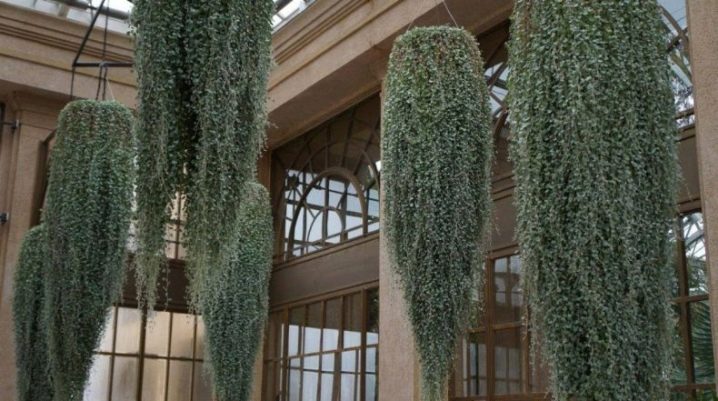
general description
Dichondra belongs to the bindweed family. It very much resembles a long liana, at home it can stretch up to two meters. Due to this, the plant is often grown as ampelous. It effectively hangs from hanging planters, reminiscent of a natural waterfall. But there are also interesting ground cover varieties.
Dichondra is perennial culture. Leaves give it a special decorative effect. They are small, round, and shaped like coins. The leaves cover the liana very densely, which gives the impression of a carpet. They can be bright green or with a silver coating. The flowers of the dichondra are very small, no more than 3 millimeters. The color differs depending on the variety, but in any case the flowers are not of decorative interest. The seed pods are like balls, there are few seeds inside.
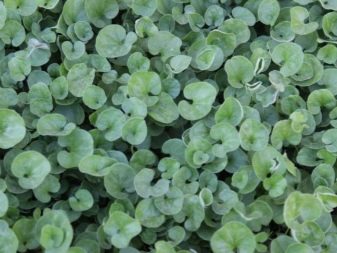
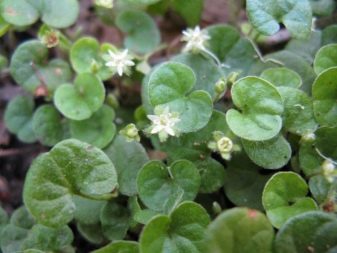
Types and varieties
In the wild, there are about a dozen different types of dichondra. But so far only one has been able to cultivate. This is a silvery dichondra. It is planted as ampelous, suitable for any conditions. There are several popular varieties of this subspecies.
-
Silver Falls. This variety has particularly long shoots, but they are not too lush. The leaves are small, silvery, falling off in a real luxurious cascade. The plant is very refreshing for the environment. But it is better to grow it outdoors, since even the slightest partial shade will negatively affect its decorative effect.
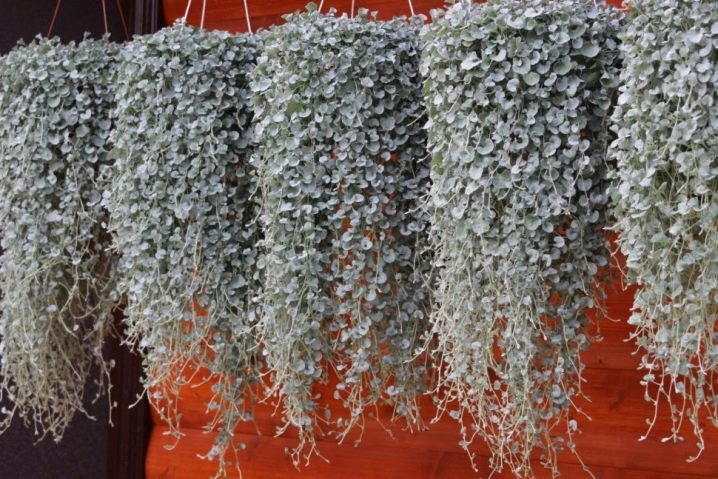
- "Silver Threads". This variety is grown only in hanging pots or boxes, away from walls, fountains, gazebos, in general, everything that it could catch on to. The leaves are formed on filamentous shoots, silvery, sometimes it even seems that the culture is dusted with snow. Can grow in partial shade.
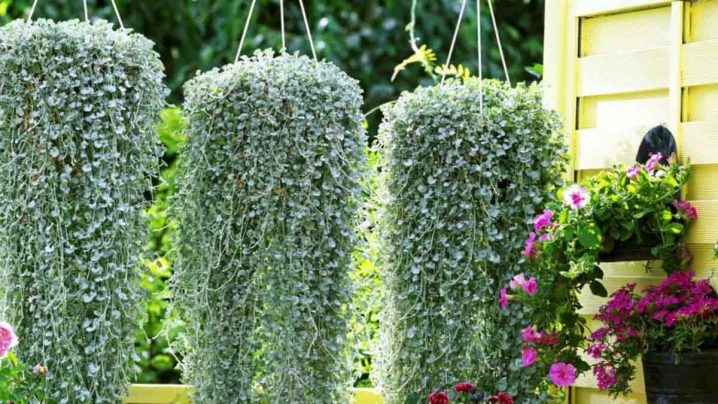
- Emerald Falls. A very interesting variety with lush, rounded foliage of an emerald hue. The shoots look more voluminous than the silvery varieties. The plant can be in the sun and in the shade, and in the shade it grows even larger. It is grown not only in pots, but also directly on the ground, creating a spectacular carpet and filling bare areas of the garden.
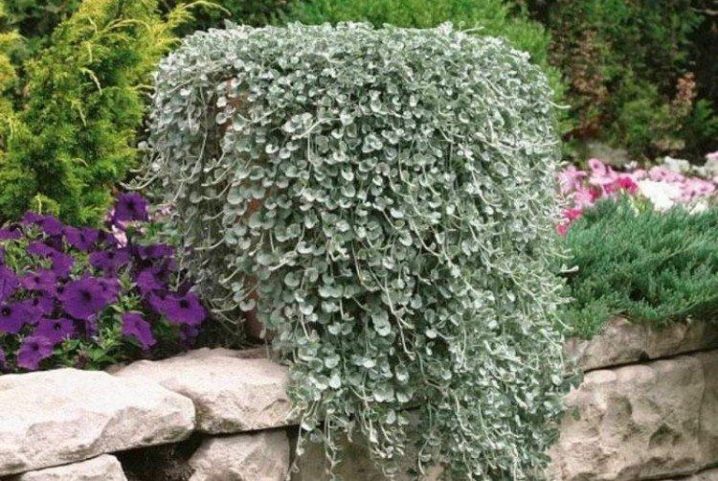
- "Emerald in Silver". One of the most spectacular dichondra varieties, combining the colors of the previous subspecies. Emerald and silver shades are perfectly combined in one plant, giving it volume and increasing decorativeness. Such a creeping vine looks incredibly magnificent.

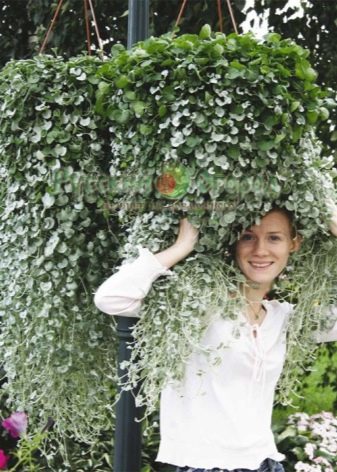
Landing
Dichondra can be planted with seeds. Initially, it is grown at home, and already strengthened is transferred to an open area (if ampelous cultivation is planned). Disembarkation is carried out at the end of winter. The pots are washed and disinfected, then loose soil with a lot of sand and peat is laid there. The substrate is slightly moistened. Next, small depressions are made in it, where the seeds are placed. Sowing depth - no more than a centimeter. The containers are covered with polyethylene or other greenhouse material and placed in a well-lit, warm place.
Every day, the film is opened for 10 minutes to let the air flow.The temperature in the room with seedlings should be 22-24 degrees Celsius. Spray the soil as needed. After 7-9 days, seedlings will break through from the ground. But the shelter is removed only after the leaves are formed. They continue to look after the seedlings, systematically watering them.
The light is provided with full-fledged, but diffused, seedlings are supplemented if necessary.
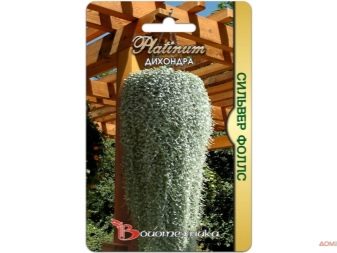
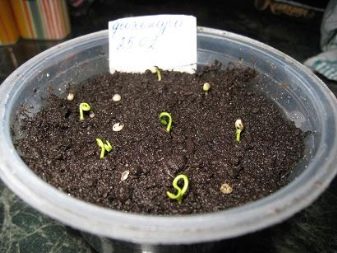
If the plantings turned out to be too dense, then the plants dive after the appearance of the second true leaf. If not, then you can do without this pick by performing the procedure when the sprouts reach a 15-centimeter height. Then you will have to transplant for sure, placing one seedling in a container and pinching the top growth point. You can transplant seedlings into open ground when the air warms up to +20 degrees. These should be specimens with at least 8 shoots.
The growing area must meet the requirements of the variety. For example, subspecies with silvery foliage need the sun, and those with emerald ones need partial shade. The landing area should not be blown by winds. As for the soil, dichondra loves light loams with a slightly acidic or neutral reaction. Planting dichondra is as easy as shelling pears. The plant must be carefully removed from the container, rinsed with a warm shower and simply planted in a small hole prepared for it. Cover with soil, water. The distance between the holes should be about 25 centimeters.
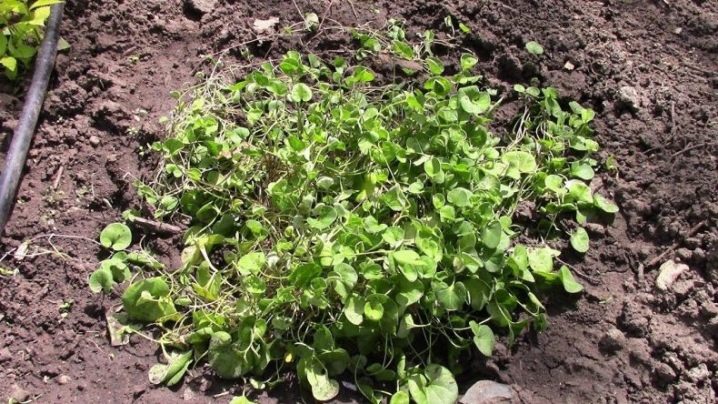
If there is a desire to grow dichondra as a ground cover, forming a whole lawn, then in this case the grains can be sown directly into the ground. This can be done from mid-spring to October. It is necessary to loosen the earth well. Seeds are scattered over the surface, the consumption will be about 12 grams per square meter. Then cover with a thin layer of soil, irrigate. The substrate should be moist until sprouts appear. When the seedlings are strengthened, they must be fed with nitrogen fertilizer.
When growing dichondra at home, the most important point is the correct choice of capacity. The pots should be wide, this is due to the characteristics of the root system. Holes are made at the bottom, drainage is put in the bottom layer.
It is worth placing about 4 seedlings in each pot, this will allow you to get the same spectacular waterfall from the leaves.
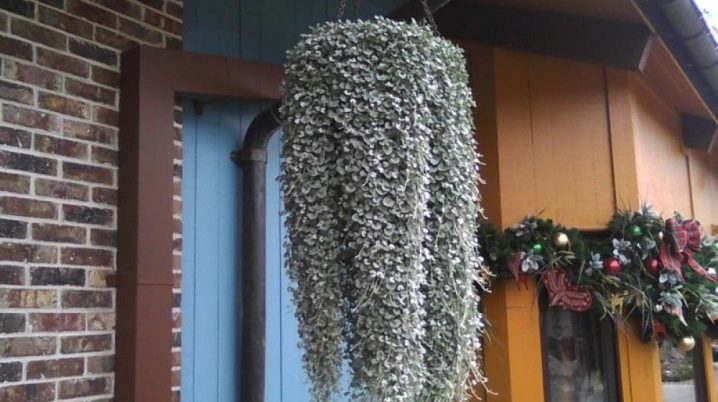
Growing care
It is not difficult to grow a dichondra, this flower is not very whimsical. But some of the cultivation features are still worth remembering.
Watering and feeding
Dichondra is considered a drought-resistant plant, but with a lack of water, it quickly loses its decorative effect. Watering will directly depend on weather conditions... In the heat it is necessary to water it often, once every few days. The soil should always remain slightly damp. It is also worth spraying the plant, but it is better to do this in the evening, in order to avoid burning the leaves. In normal weather, watering is carried out every 4-5 days. It is worth considering the level of groundwater occurrence. If they are close to the surface, then in comfortable weather, you can limit yourself to weekly watering.
Initial dressings are applied as soon as the first two leaves appear on the shoots. Then the nutrients should be supplied to the plants every 2-3 weeks. For growth, they can be fed with nitrogen, since this culture constantly needs it for a quick set of green mass. And also a good effect will be given by top dressing containing potassium. You can also fertilize a flower with complex fertilizing for flowering crops. All meals are served to flowers from March to late autumn. In winter, it is not customary to fertilize dichondra.
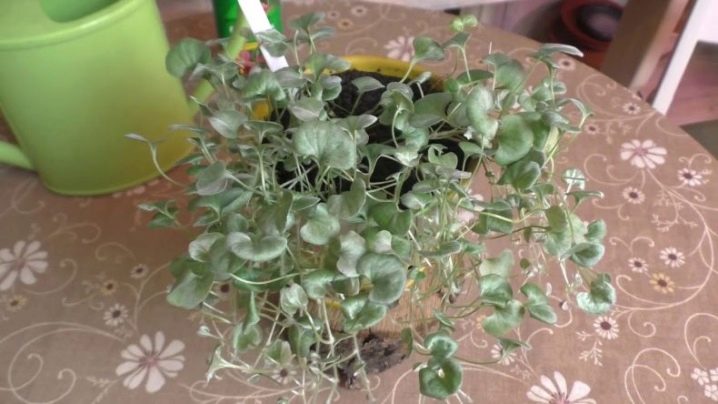
Transfer
Dichondra will have to be transplanted infrequently. This is done only when the roots begin to break through the holes in the bottom. This means that the pot is too small. A larger container is selected, it should also have holes, a drainage layer. The flower is watered and then waited for about half an hour. Next, it remains to gently pry it around the perimeter with a spatula and pull it out of the pot along with the ground.
Using the transshipment method, the plant is installed in a new container, the soil is poured, without ramming, and irrigated. Next, the container with dichondra is placed in partial shade for several days so that the plant takes root.

Wintering
In most regions of the country, dichondra is grown outdoors as an annual. The plant is not cold-resistant, at -10 the entire root system dies. If you do not want to lose the culture, then shortly before frost you need to completely cut off all the shoots with foliage, and dig up the root. Together with the ground, it is taken to a cool and ventilated room. Cover with wet sand to avoid drying. When spring comes, the root will sprout. They are separated, seated in containers, and when warm weather is established, they are taken out into the open ground.
If the winter is warm (not lower than -3 ... 5 degrees), then the dichondra can also overwinter outside. It is well covered with earth, and then covered with polyethylene. Lay a layer of dry foliage on top.
In the conditions of apartments, however, usually no problems arise. The pot is placed in a room with a temperature of 15-16 degrees, it is possible on a loggia if it is glazed. Watering for the winter period is limited, but not completely stopped. Observing all these rules, dichondra can be successfully preserved in winter.
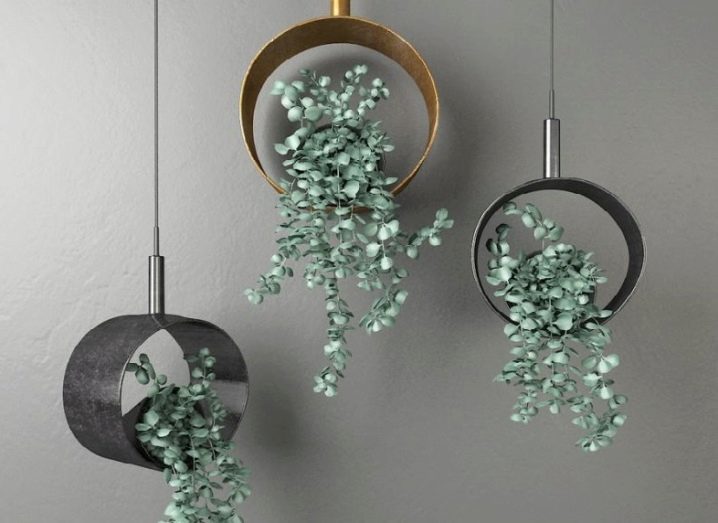
Reproduction
Propagating a culture is very easy. The seed method was described above, but it is not the only one. You can also carry out reproduction by layering and cuttings.
-
Layers... Loosen the soil around the plant and find a healthy, strong shoot. Bend it to the ground, secure and dig in. For reliability, it can be watered with growth or root stimulants. Place the film on top. After a couple of weeks, you will see new roots. You can transplant the layer after the appearance of 4 leaves.
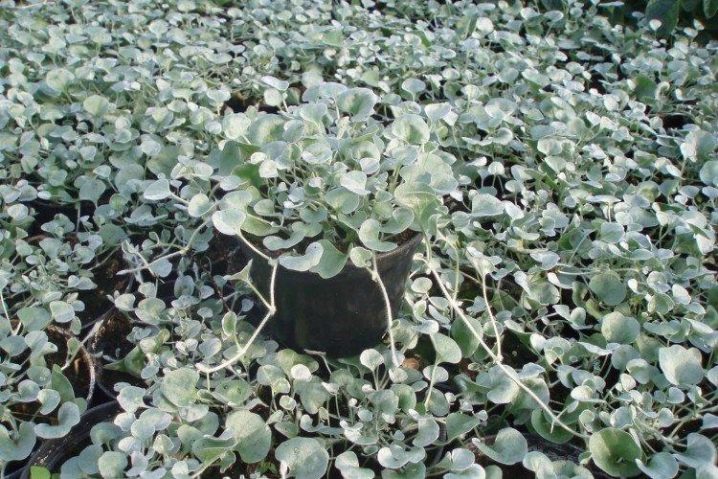
- Cuttings... Cuttings also do not cause difficulties for gardeners. In early spring, you need to cut several cuttings, place them in containers of water. After a week, transplant into pots with peaty-sandy soil. After another week, transplant again, now in flowerpots or more voluminous pots. Organize a mini greenhouse on top. It will be necessary to remove it only after the appearance of the kidneys.

Diseases and pests
Dichondra has excellent immunity. From a biological point of view, this is a weed, and they are known to be least susceptible to any ailments. The only disease that can occur is root rot... But this will only be the case if the plant is constantly flooded. Indoor culture is easy to cure, you just need to transplant it into another container and change the soil. Outdoor plants are treated with fungicides.
Much more often, the leaves begin to curl up. This is not a sign of illness, but a symptom of a lack of moisture. It is worth increasing the amount of watering and feeding the plant. If the silver variety turns green, it means that it lacks lighting.

Insects fly to dichondra very rarely. Weevils, whiteflies, aphids can start, but in extreme cases. Traditional methods and insecticide treatment will quickly remove parasites. The situation is much worse if the plant is affected by nematodes. It is impossible to get rid of the worm, diseased plants will have to be dug up, and healthy plants will have to be transplanted. Where the nematode parasitized, the soil must be cultivated. New crops cannot be planted in this area for several years.
Protecting plants from pests and diseases is easy. You just need to perform a few simple steps:
-
timely destroy weeds near;
-
limit the amount of watering if the plant has grown excessively (moisture does not have time to evaporate);
-
make top dressing containing not only nitrogen, but also other useful substances.
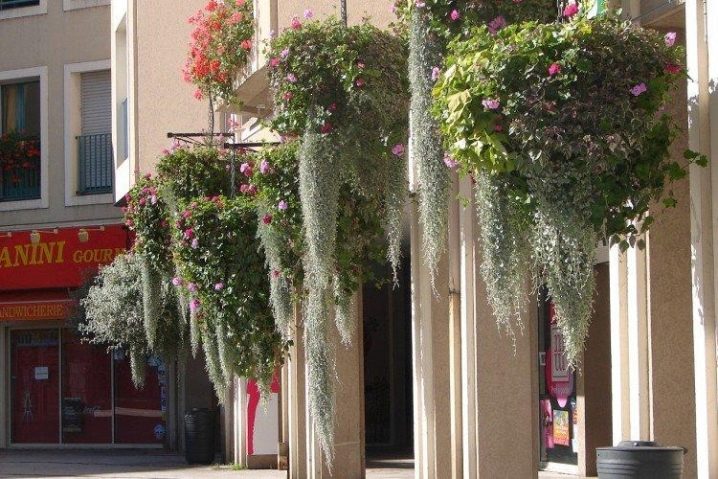
Application in landscape design
Dichondra is an incredibly beautiful ornamental plant that can be used to create many amazing compositions. It is especially good when planting in open ground. In the garden, dichondra goes well with other flowers, for example, begonia, fuchsia, petunia.She sets them off with her unobtrusive background.
The brighter the flower growing nearby, the more interesting the contrast will be.
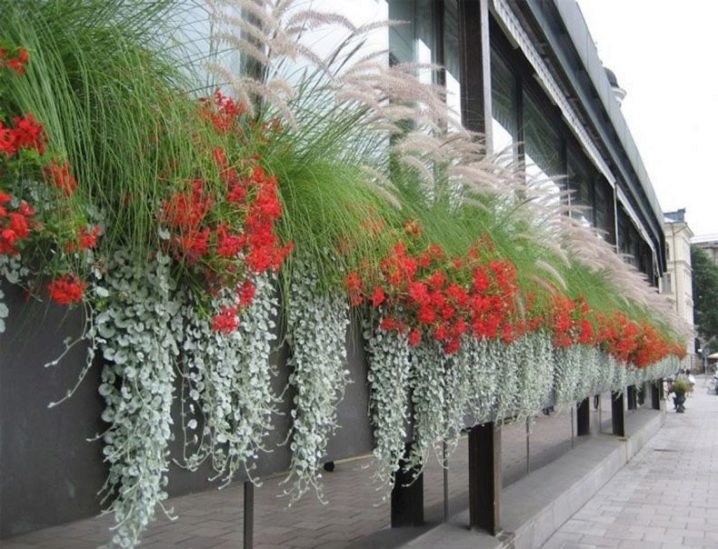
Dichondra looks very beautiful near water. It can be either an artificial pond or a summer cottage pool. A stunning effect is given by the appearance of a flower, which itself resembles a waterfall.
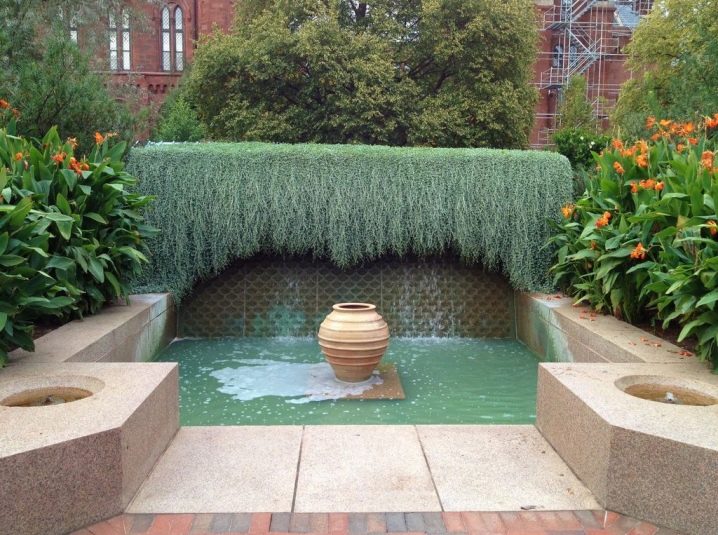
And also the culture grows well in ordinary flower beds, rockeries, it can serve as a decoration for an alpine slide. Often, plants are planted in massive flowerpots and frame terraces, entrances to gazebos and pergolas with them.
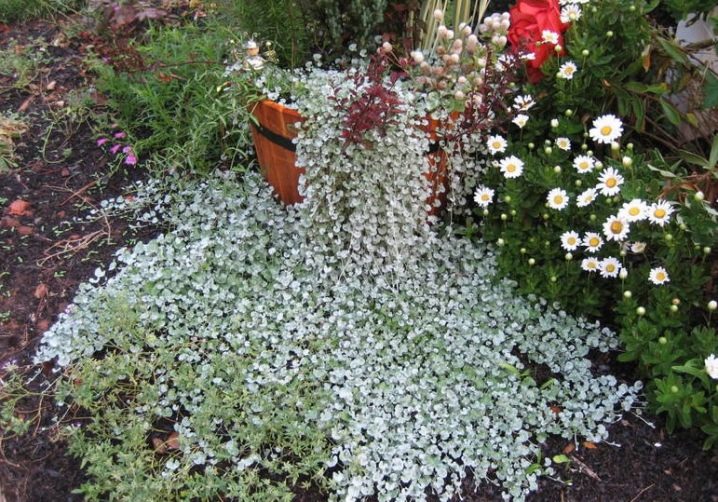
Another use case is an alternative lawn. You can always plant dichondra instead of regular grass. It will expand and cover the entire planting area with a lush carpet. This trick is also used by gardeners to hide bald spots and empty areas in the garden, as well as unsightly voids between the tiles of the paths.
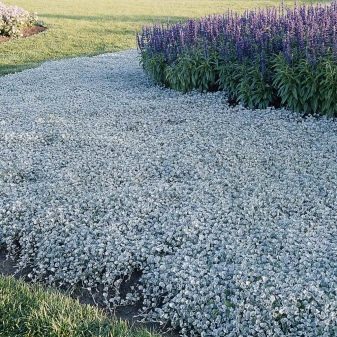














The comment was sent successfully.